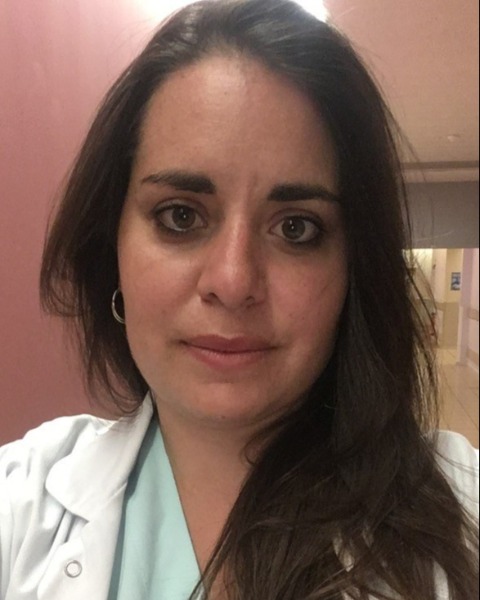Female Reproductive Tract
Poster Session B
(P-148) Uterus healing after cesarean: development of a rabbit model
Thursday, July 18, 2024
8:00 AM - 9:45 AM IST
Room: The Forum
- PC

Elodie Debras, PhD student (she/her/hers)
First author
Elodie Debras, APHP, INRAE
LE KREMLIN BICETRE(94270), Ile-de-France, France
Poster Presenter(s)
Author(s)
Abstract Authors: Elodie DEBRAS a,b,c, Constance MAUDOT a, Jean-Marc ALLAIN d , Angelo PIERANGELO e, Julie RIVIERE f, Michèle DAHIREL b, Christophe RICHARD b, Valérie GELIN b, Gwendoline MORINg, Perrine CAPMAS a,h, Pascale CHAVATTE-PALMER b
a Department of gynecology and obstetrics, CHU de Bicêtre, AP-HP, DMU2, 78, rue du Général-Leclerc, 94270 Le Kremlin-Bicêtre, France
b University Paris-Saclay, UVSQ, INRAE, BREED, 78350 Jouy-en-Josas, France
c University Paris-Saclay, 63, rue Gabriel-Péri, 94270 Le Kremlin-Bicêtre, France
d LMS, CNRS, Ecole Polytechnique, Institut Polytechnique de Paris, Palaiseau, France; Inria, Palaiseau, France
e LPICM, CNRS, Ecole polytechnique, IP Paris, 91128, Palaiseau, France
f University Paris-Saclay, UVSQ, INRAE, @bridge, 78350 Jouy-en-Josas, France
g University Paris-Saclay, UVSQ, INRAE, @bridge, 78350 Jouy-en-Josas, France
h CESP-Inserm U1018 « Reproduction et développement de l'enfant », 82, rue du Général-Leclerc, 94270 Le Kremlin-Bicêtre, France
Abstract Text:
Introduction: Abnormal scarring tissue after Caesarean in humans often result in complications such as scar defect, and has been suspected to induce multiple gynecological and obstetrical complications. The objective of this study was to develop an in-vivo model of uterus healing after cesarean in order to analyze histological phenomena controlling scarring tissue development and potential cause of defects. Knowing the complex process of uterus healing could help improve the management of scarred uterus.
Methods: The study was conducted in a public research institute after agreement of ethical authorities. Eighteen pregnant primiparous female rabbits were bred naturally. At 28 days of gestation (G28), under general anesthesia, a cesarean was practiced. Fetuses were either extracted through a longitudinal incision in one of the uterine horns (“C-section”) or via a single incision at the tip of the contralateral horn (“control”). Uterine horns were sutured by single layer, all by the same surgeon. They were mated again 14 days later and euthanized at G28. Genital tracts were collected for histological and biomechanical analyses.
Results: Macroscopically, 4/18 C-section horns presented a dehiscence or a spontaneous rupture. After inclusion in paraffin, 5 µm cut, and Hematoxylin, eosin and safran stain, mean thickness of the scarred area was significantly lower vs non-scarring area on C-section horns vs control horns (respectively 1.01±0.65 mm vs 1.73±0.45 mm vs 1.46±0.34 mm, p=0,03). The percentage of fibrosis in the scar zone, calculated using Image J software, was significantly higher in the scar zone than in the non-scar zone (C-section horn) or in the control horn. Biomechanical characteristics of the C-section versus control horns were different on the stress-strain curves. From a mechanical point of view, the scar was a zone of mechanical weakness. However, the scarred tissue was very hard and stiff (collagen), and could sustain a traction force almost similar to the non-scar tissue.
Conclusion: Although C-section conditions were standardized, uterine healing differed between individuals. Biomechanical analyses seem to confirm histologic findings. These results suggest that this model may be useful for studying uterine healing efficiency according to individual characteristics and suture mode.
a Department of gynecology and obstetrics, CHU de Bicêtre, AP-HP, DMU2, 78, rue du Général-Leclerc, 94270 Le Kremlin-Bicêtre, France
b University Paris-Saclay, UVSQ, INRAE, BREED, 78350 Jouy-en-Josas, France
c University Paris-Saclay, 63, rue Gabriel-Péri, 94270 Le Kremlin-Bicêtre, France
d LMS, CNRS, Ecole Polytechnique, Institut Polytechnique de Paris, Palaiseau, France; Inria, Palaiseau, France
e LPICM, CNRS, Ecole polytechnique, IP Paris, 91128, Palaiseau, France
f University Paris-Saclay, UVSQ, INRAE, @bridge, 78350 Jouy-en-Josas, France
g University Paris-Saclay, UVSQ, INRAE, @bridge, 78350 Jouy-en-Josas, France
h CESP-Inserm U1018 « Reproduction et développement de l'enfant », 82, rue du Général-Leclerc, 94270 Le Kremlin-Bicêtre, France
Abstract Text:
Introduction: Abnormal scarring tissue after Caesarean in humans often result in complications such as scar defect, and has been suspected to induce multiple gynecological and obstetrical complications. The objective of this study was to develop an in-vivo model of uterus healing after cesarean in order to analyze histological phenomena controlling scarring tissue development and potential cause of defects. Knowing the complex process of uterus healing could help improve the management of scarred uterus.
Methods: The study was conducted in a public research institute after agreement of ethical authorities. Eighteen pregnant primiparous female rabbits were bred naturally. At 28 days of gestation (G28), under general anesthesia, a cesarean was practiced. Fetuses were either extracted through a longitudinal incision in one of the uterine horns (“C-section”) or via a single incision at the tip of the contralateral horn (“control”). Uterine horns were sutured by single layer, all by the same surgeon. They were mated again 14 days later and euthanized at G28. Genital tracts were collected for histological and biomechanical analyses.
Results: Macroscopically, 4/18 C-section horns presented a dehiscence or a spontaneous rupture. After inclusion in paraffin, 5 µm cut, and Hematoxylin, eosin and safran stain, mean thickness of the scarred area was significantly lower vs non-scarring area on C-section horns vs control horns (respectively 1.01±0.65 mm vs 1.73±0.45 mm vs 1.46±0.34 mm, p=0,03). The percentage of fibrosis in the scar zone, calculated using Image J software, was significantly higher in the scar zone than in the non-scar zone (C-section horn) or in the control horn. Biomechanical characteristics of the C-section versus control horns were different on the stress-strain curves. From a mechanical point of view, the scar was a zone of mechanical weakness. However, the scarred tissue was very hard and stiff (collagen), and could sustain a traction force almost similar to the non-scar tissue.
Conclusion: Although C-section conditions were standardized, uterine healing differed between individuals. Biomechanical analyses seem to confirm histologic findings. These results suggest that this model may be useful for studying uterine healing efficiency according to individual characteristics and suture mode.
